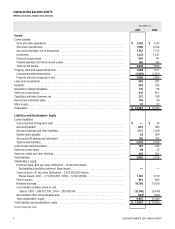Texas Instruments 2007 Annual Report Download - page 19
Download and view the complete annual report
Please find page 19 of the 2007 Texas Instruments annual report below. You can navigate through the pages in the report by either clicking on the pages listed below, or by using the keyword search tool below to find specific information within the annual report.TEXAS INSTRUMENTS 2007 ANNUAL REPORT 17
circumstances. This standard will also require additional disclosures in both annual and quarterly reports. SFAS 157 will be effective for
financial assets and liabilities in financial statements issued for fiscal years beginning after November 15, 2007, and will be effective for
non-financial assets and liabilities in financial statements issued for fiscal years beginning after November 15, 2008. We have evaluated
the potential impact of this standard and anticipate it will have no material impact on our financial position and results of operations.
In February 2007, the FASB issued SFAS No. 159, “The Fair Value Option for Financial Assets and Financial Liabilities–Including an
Amendment of FASB Statement No. 115.” SFAS 159 permits companies to choose to measure at fair value many financial instruments
and certain other items that are not currently required to be measured at fair value. Entities choosing the fair value measurement would
be required to recognize subsequent changes in the fair value of those instruments and other items directly in earnings. This standard
also establishes presentation and disclosure requirements designed to facilitate comparisons between companies that choose different
measurement attributes for similar types of assets and liabilities. SFAS 159 is effective beginning the first fiscal year that begins after
November 15, 2007. At this time, we do not anticipate electing to use the fair value measurements permitted by this standard.
In June 2007, the FASB ratified EITF Issue No. 06-11, “Accounting for Income Tax Benefits of Dividends on Share-Based Payment
Awards.” EITF 06-11 provides for the recognition and classification of deferred taxes associated with dividends or dividend equivalents
on non-vested equity shares or non-vested equity share units that are paid to employees and charged to retained earnings. This
issue is effective for annual periods beginning after September 15, 2007. We have evaluated the potential impact of this standard and
anticipate it will have no material impact on our financial position and results of operations.
Also in June 2007, the FASB ratified EITF Issue No. 07-3, “Accounting for Advance Payments for Goods or Services to Be Used in Future
Research and Development Activities.” EITF 07-3 provides that non-refundable advance payments made for goods or services to be
used in future research and development activities should be deferred and capitalized until such time as the related goods or services
are delivered or are performed, at which point the amounts would be recognized as an expense. This issue is effective for fiscal years
beginning after December 15, 2007. We have evaluated the potential impact of this standard and anticipate it will have no material
impact on our financial position and results of operations.
In December 2007, the FASB concurrently issued SFAS No. 141(R), “Business Combinations” and SFAS No. 160, “Noncontrolling
Interests in Consolidated Financial Statements–An Amendment of ARB No. 51.” SFAS 141(R) provides new guidance on the recognition,
measurement and subsequent accounting for assets acquired and liabilities assumed in business combination transactions. In addition,
SFAS 141(R) will change the accounting treatment for certain specific items in business combinations, including for example, expensing
acquisition-related costs, recording acquired contingent liabilities/assets at their acquisition-date fair value and capitalization of
in-process R&D costs. In the event that an entity owns less than 100 percent ownership interest, SFAS 160 provides for the recognition,
measurement and subsequent accounting for the non-controlling (i.e., minority) interest included in the entity’s consolidated financial
statements. Both of these standards require measurements based on fair value as determined under the provisions of SFAS 157.
In addition, both of these standards also include expanded disclosure requirements. SFAS 141(R) and SFAS 160 will be effective
prospectively for business combinations for which the acquisition date occurs during or subsequent to the first annual reporting period
beginning on or after December 15, 2008. The impact that adoption of SFAS 141(R) and SFAS 160 will have on our financial position
and results of operation will be dependent upon the specific terms of any applicable future business combinations or acquisitions of
minority interests.
Also in December 2007, the FASB ratified EITF Issue No. 07-1, “Accounting for Collaborative Arrangements Related to the Development
and Commercialization of Intellectual Property.” EITF 07-1 applies to collaborations between companies in which each participant is
exposed to significant risks and rewards depending on the venture’s commercial success, but which does not result in the creation
of a legal entity separate from the participants. EITF 07-1 addresses the accounting and disclosure requirements for these types
of collaborative arrangements and is effective for fiscal years beginning after December 15, 2008. We are currently evaluating the
potential impact this standard will have on our financial position and results of operations.
























